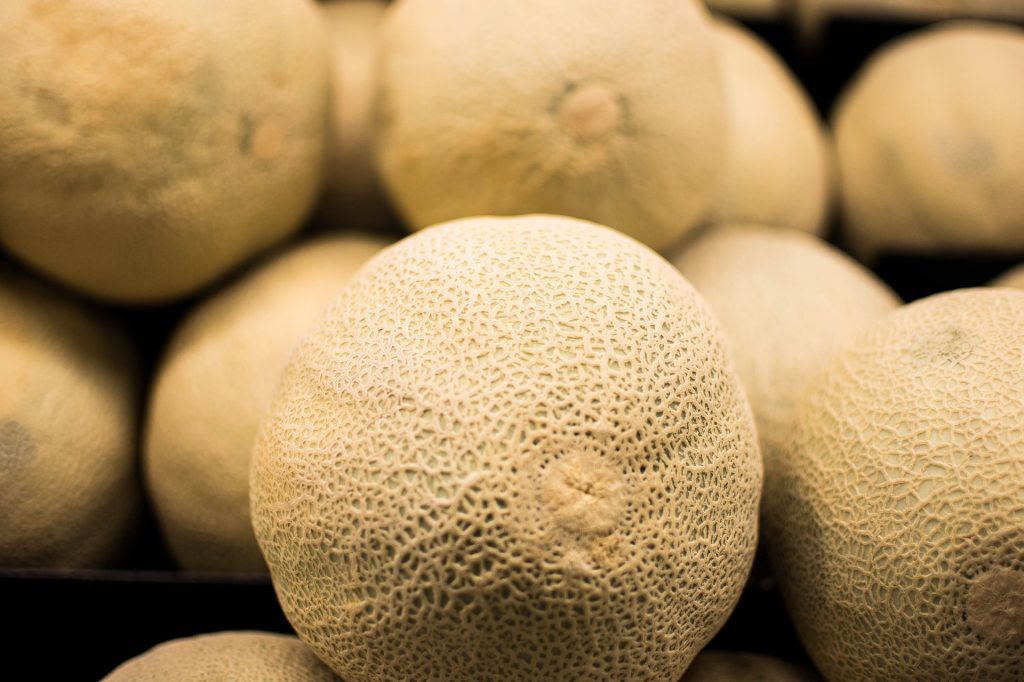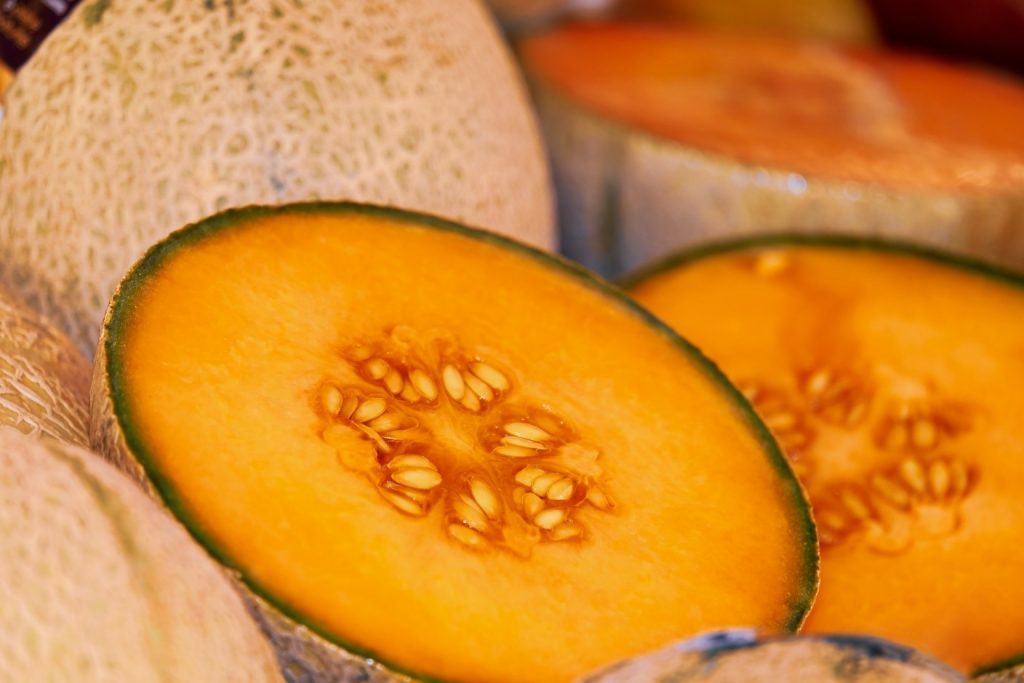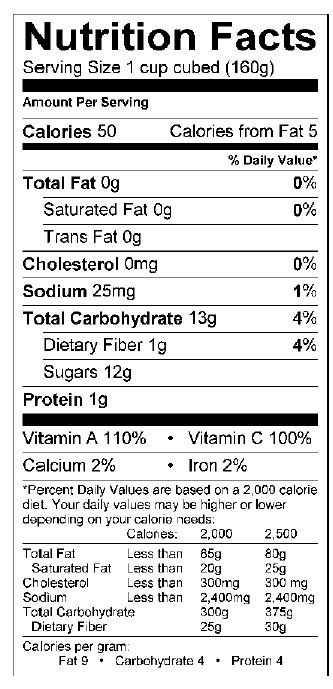Seasonality
Colorado grown cantaloupes are available August through October and cantaloupes are sold in many grocery stores year round.

Is it okay for me to eat a cantaloupe that looks ‘blemished’ on the outside?
This blemish is most likely the ‘ground spot,’ or where the melon rested on the ground during its growing period. This side of the melon may look different and be slightly less ripe, however, it is still good to eat. The spot may also be caused by ‘sun scald,’ or a side of the fruit exposed to too much sun. Sunspots on melons do not affect their quality unless it is unusually severe.
Cantaloupe is a type of melon characterized by a webbed surface. The scientific name of this fruit is Cucumis melo, also known as muskmelon. It belongs to the Cucurbitaceae family, which includes melons, squash, and cucumbers. Cantaloupes are named for the papal gardens of Cantalupo, Italy where some historians report this species of melon was first grown. When ripe, cantaloupes have a sweet fragrance and the blossom end of the fruit should yield to moderate pressure.
Selection
When selecting cantaloupe, those with a stem attached may indicate the cantaloupe was harvested early. Choose fragrant, symmetrical cantaloupes that are heavy for their size with a yellow or cream undertone and no major bruises. Ripe cantaloupes will yield slightly to pressure on the blossom end. Avoid cantaloupes that have a cut outer rind, are mushy, molded, shriveled, or leaking.
Colorado Production of Cantaloupes

Colorado’s melon production is centered in the Arkansas Valley around Rocky Ford, a name that is synonymous with cantaloupe melons. Since 1895, the Arkansas Valley has been producing the highest quality cantaloupes. U.S. commercial cantaloupe production actually began in the Arkansas Valley very near the town of Rocky Ford. Many people travel to the Arkansas Valley each year to sample the delicious melons, tour the melon fields, and take a few home.
Researchers say that Rocky Ford melons are sweet because of the wide temperature swings that the region experiences during the summer. Days can reach as hot at 100°F while nights may have lows in the 50’s. The combination of warm weather, dry climate, and high elevation (4,000 feet above sea level) may increase sugar production. The cool Colorado nights then allow the sugars to accumulate in the melons as the growing process slows down.
Safe Handling and Preparation

Unless using within a day, store whole melons in the refrigerator in a clean bowl or colander. Always wash hands, knives, and cutting board before cutting. Place bowl in a sink and wash the outside melon rind thoroughly under cool running water. Scrub well with a clean vegetable brush to remove soil or bacteria on the rind that might be carried from the knife blade to the flesh during cutting, blot dry with paper towels. Using a clean cutting board and knife, slice the melon in half and scoop out the seeds and strings. Wash knife between cuts. Melons can be cut into halves, quarters, wedges, cubes, or balls.

Nutrition
Cantaloupes are rich in nutrients that fight disease, including cancer. They contain significant amounts of Vitamins A and C, are a good source of potassium and folate, and contain small amounts of many minerals. Cantaloupes are fat free and very low in sodium.
Buying Cut Melon
If purchasing a cut or diced melon, make sure that the container is stored in a chilled area, preferably a refrigerated case. If cut melon is displayed on ice, make sure the entire bottom half of the container is covered and the lid is cold to the touch.
Cantaloupe Pickles
- 5 pounds of 1-inch cantaloupe cubes(about 2 medium under-ripe* cantaloupe)
- 1 teaspoon crushed red pepper flakes
- 2 one-inch cinnamon sticks
- 2 teaspoons ground cloves
- 1 teaspoon ground ginger
- 4 1/2 cups cider vinegar (5%)
- 2 cups water
- 1 1/2 cups white sugar
- 1 1/2 cups packed light brown sugar
*Select cantaloupe that are full size but almost fully green and firm to the touch in all areas including the stem area.
Day One:
1.)Wash cantaloupe and cut into halves; remove seeds. Cut into 1 inch slices
and peel. Cut strips of flesh into 1 inch cubes. Weigh out 5 pounds of pieces
and place in large glass bowl.
2.) Place red pepper flakes, cinnamon sticks, cloves and ginger in a spice bag and tie the ends firmly. Combine vinegar and water in a 4-quart stockpot. Bring to a boil, then turn heat off. Add spice bag to the vinegar-water mixture, and let steep for 5 minutes, stirring occasionally.
3.) Pour hot vinegar solution and spice bag over melon pieces in the bowl. Cover with a food-grade plastic lid or wrap and let stand overnight in the refrigerator (about 18 hours).
Day Two:
4.) Wash and rinse pint canning jars; keep hot until ready to use. Prepare lids
according to manufacturer’s directions.
5.) Carefully pour off vinegar solution into a large 8 to 10 quart saucepan and bring to a boil. Add sugar; stir to dissolve. Add cantaloupe and bring back to a boil. Lower heat to simmer until cantaloupe pieces turn translucent; about 1 to 11/4 hours.
6.) Remove cantaloupe pieces into a medium-sized stockpot, cover and set aside. Bring remaining liquid to a boil and boil an additional 5 minutes. Return cantaloupe to the liquid syrup, and bring back to a boil.
7.) With a slotted spoon, fill hot cantaloupe pieces into clean, hot pint jars, leaving 1-inch headspace. Cover with boiling hot syrup, leaving 1/2-inch headspace. Remove air bubbles and adjust headspace if needed. Wipe rims of jars with a dampened clean paper towel; apply two-piece metal canning lids.
8.) Process in a boiling water canner according to the recommendations in Table 1. Let cool, undisturbed, 12-24 hours and check for properly closed seals.
| Table 1: Recommended process time for Cantaloupe pickles in a boiling-water canner | ||||
| Process time at altitudes of: | ||||
| Style of Pack | Jar Size | 0-1,000 ft | 1,001-6,000 ft | Above 6,000 ft |
| Hot | Pints | 15 min | 20 min | 25 min |


